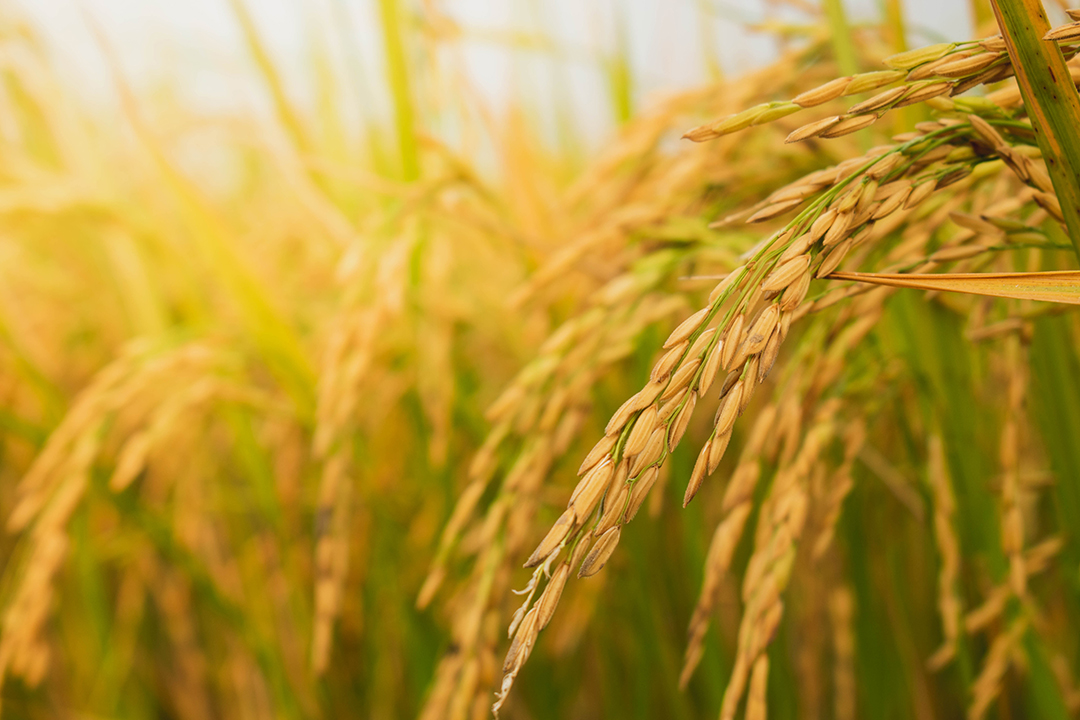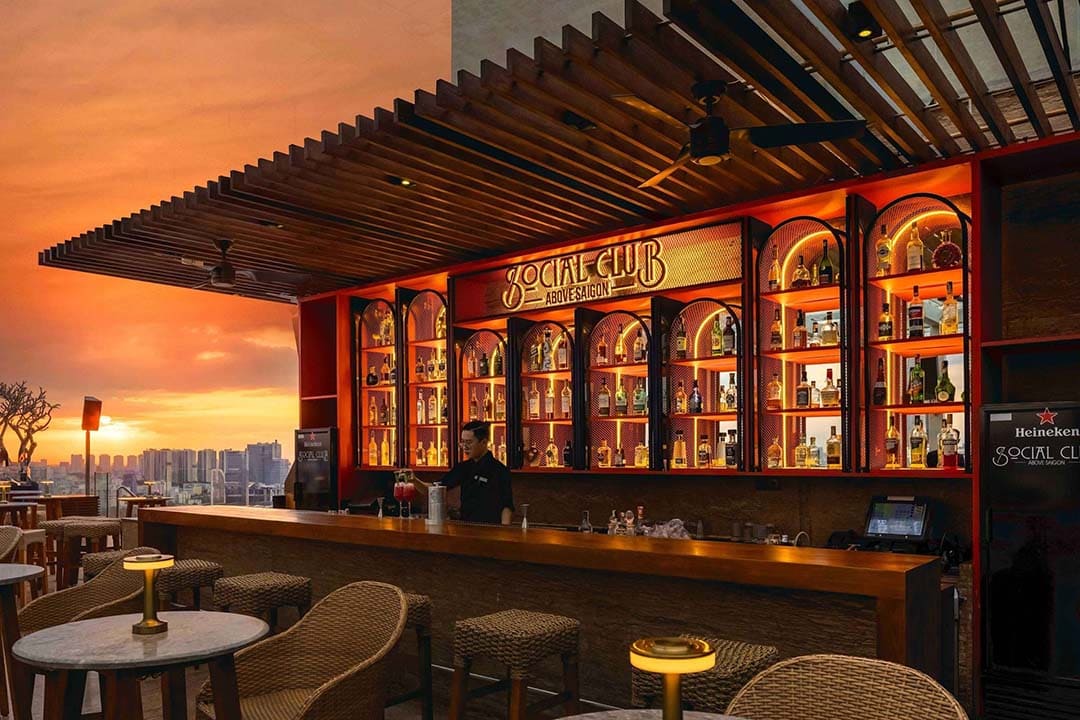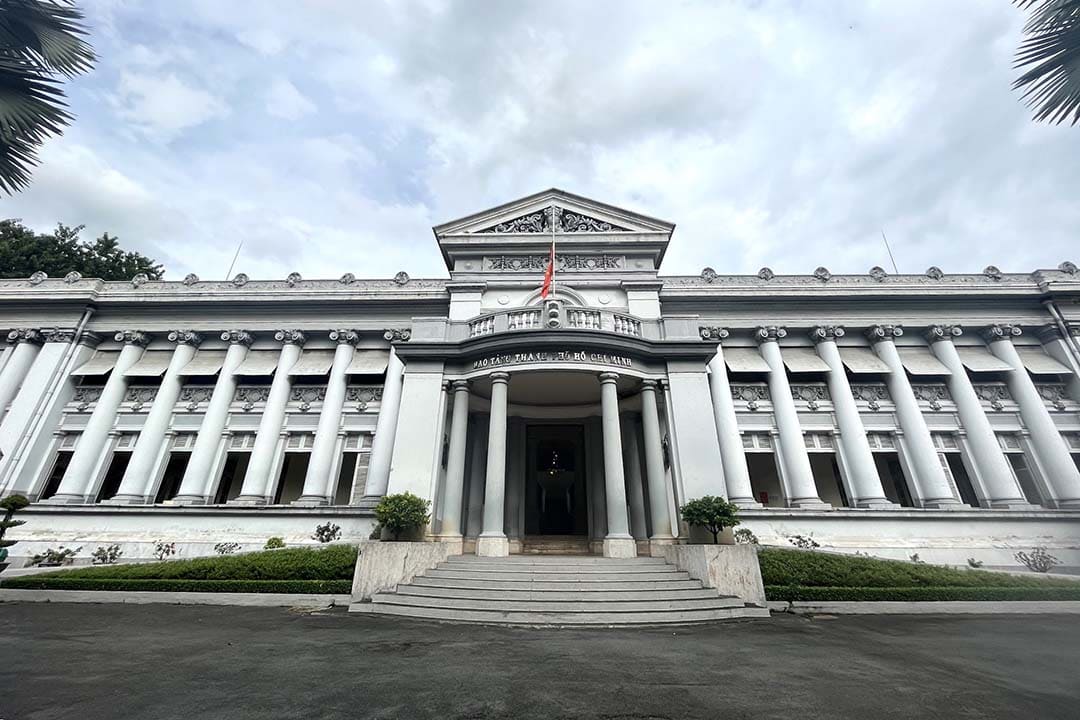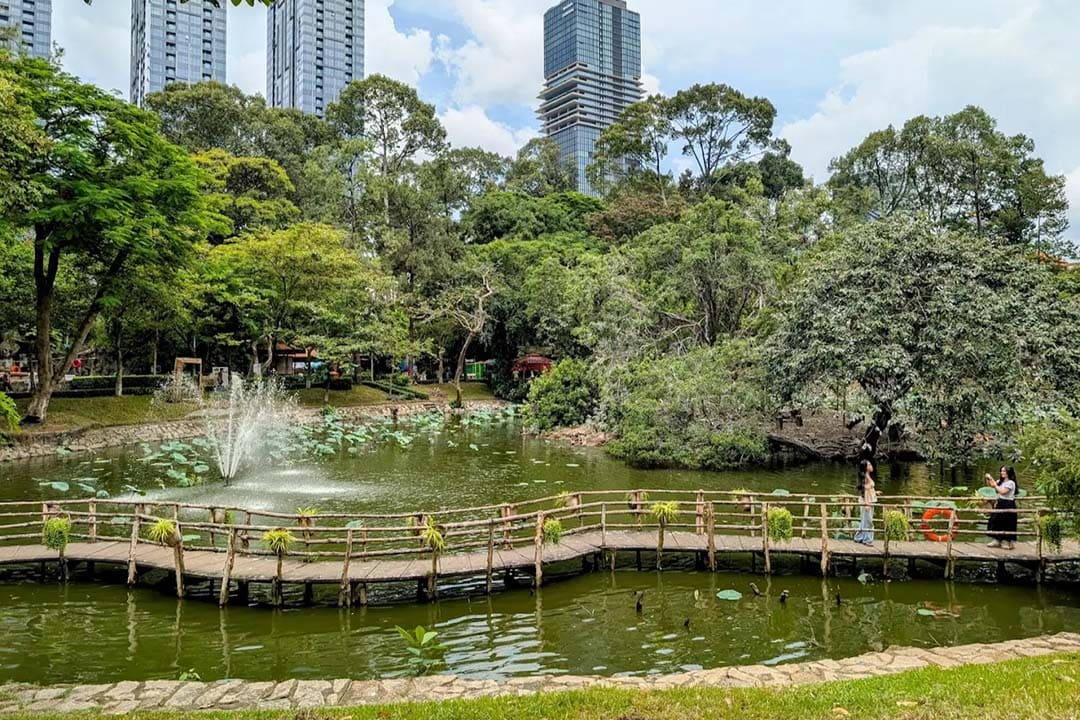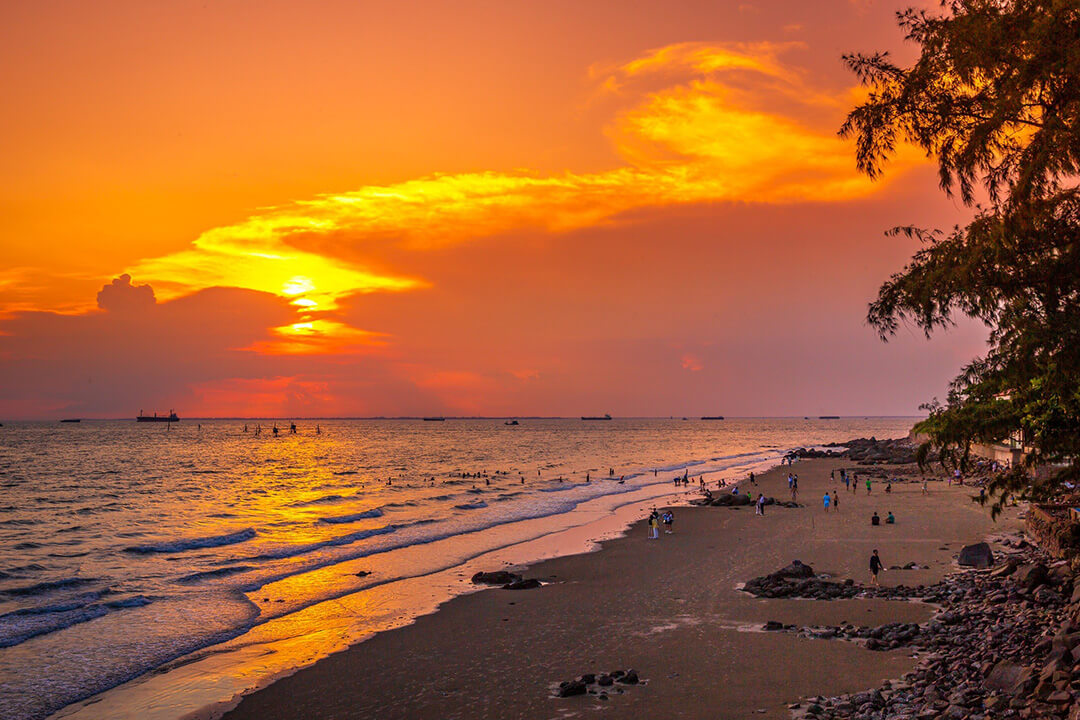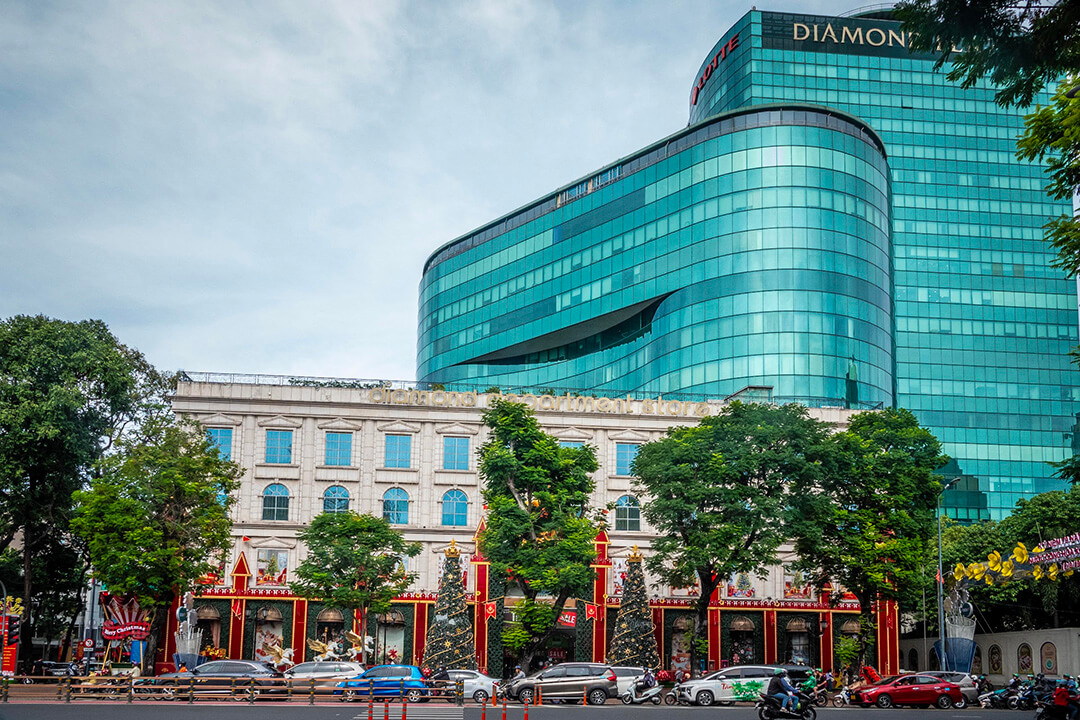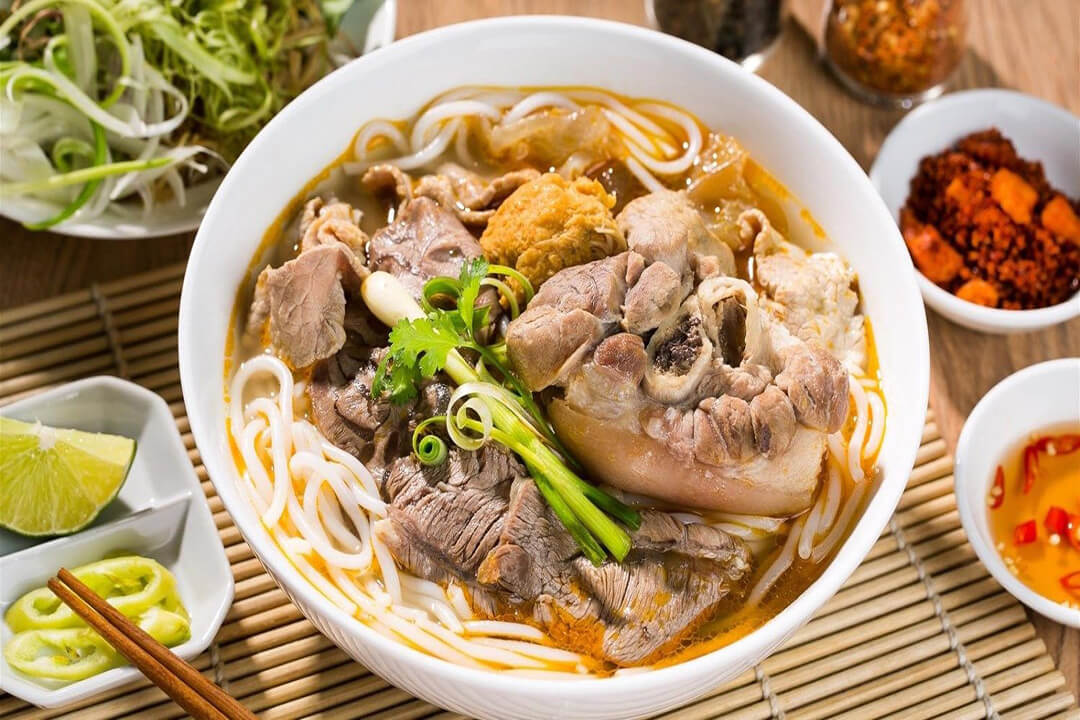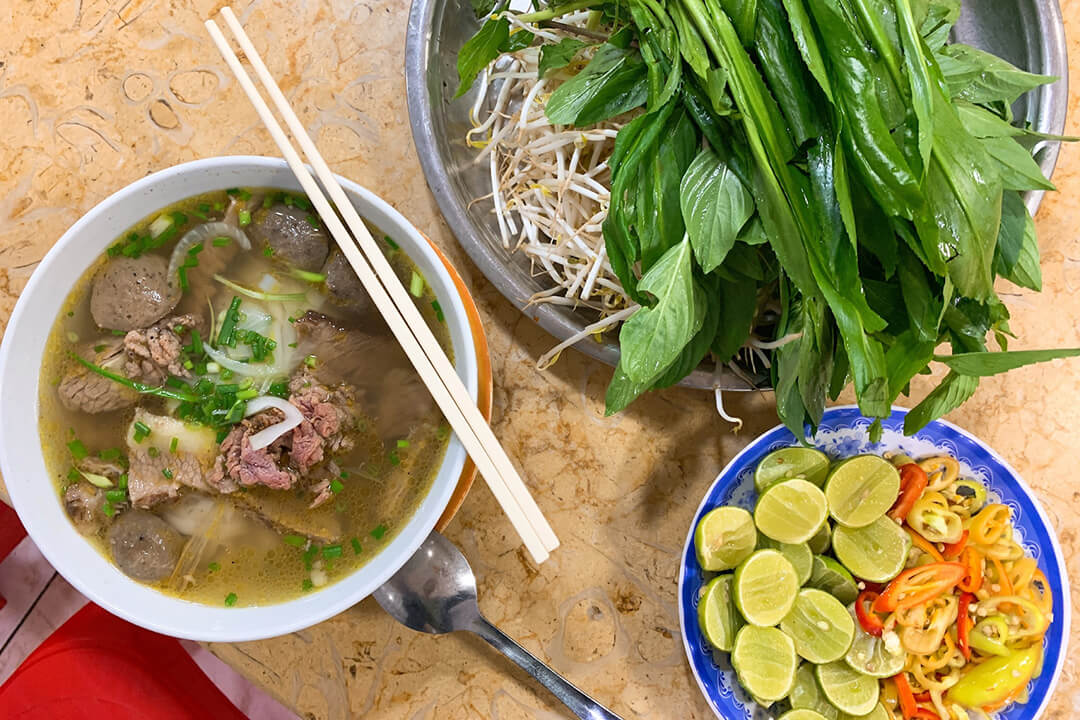Sep - 17 - 2025
Located in northern Vietnam, Ninh Binh is renowned for its breathtaking landscapes of towering karsts and lush scenery. Yet, the province also boasts a rich trove of historical and spiritual landmarks, including an array of ancient temples and pagodas that date back centuries.
These temples are not only unique architectural works but also carry profound historical and cultural values. From the grandeur of Bai Dinh Pagoda to the serenity of Thai Vi Temple, each location tells its own story, reflecting the spirituality and attachment of the people here to Buddhist beliefs.
In Ninh Binh, there are quite a few temples and pagodas, but the most prominent among them are about 10 locations (including temples and pagodas). This will make you wonder which is the most famous temple in Ninh Binh, or give some tips when visiting temples. Temples and pagodas in Ninh Binh will all be answered in GTrip’s top 10 Ninh Binh Temples and Pagodas article.
1. Bai Dinh Pagoda
The pagoda is located at the western gateway of the Hoa Lu ancient capital relic site, on National Highway 38B, in Gia Sinh commune – Gia Vien – Ninh Binh. It is 15 km from Ninh Binh city. The pagoda is surrounded by lush forests and overlooks the scenic valleys of the Trang An Landscape Complex.
Bai Dinh Pagoda, originating in the 11th century under the Ly dynasty, began as a modest temple honoring local deities and Buddhist saints. Over time, it evolved into a revered cultural site, embodying Vietnam’s deep connection to Buddhism.
The modern complex, completed in 2010, blends ancient traditions with contemporary Buddhist practices, attracting spiritual leaders and practitioners from across Asia. Today, Bai Dinh stands as a symbol of Vietnamese heritage and Buddhist pride, fostering cultural exchange and representing Vietnam’s enduring Buddhist legacy.
Bai Dinh Pagoda impresses with its vast scale and blend of traditional Vietnamese design and monumental architecture. Spanning 539 hectares, it features a 100-ton bronze Buddha, symbolizing peace, and a 1-kilometer corridor lined with 500 unique Arhat statues.
Natural materials and traditional elements like upturned tile roofs, dragon carvings, and lotus motifs integrate the complex beautifully with its mountain and lake surroundings. This design reflects a harmonious connection between Buddhist spirituality and nature. A 36-ton bronze bell in the tower adds to the site’s serene and reverent atmosphere.
Each spring, Bai Dinh Pagoda comes alive with its annual festival from Lunar New Year to March, drawing pilgrims from across Vietnam who pray for health, luck, and happiness. This cherished Buddhist event features ceremonies, processions, and cultural performances, blending reverence with festivity. Bai Dinh also hosts major events like Vesak Day, celebrating Buddha’s birth, enlightenment, and passing, attracting Buddhists worldwide and reinforcing its role as a global spiritual hub. These gatherings foster unity and cultural exchange, cementing Bai Dinh as a beloved center for Buddhist devotion.

Beautiful landscape of Bai Dinh Pagoda
2. Thai Vi Temple
Thai Vi Temple is situated in the heart of Ninh Binh, nestled among the region’s iconic karst formations and lush, verdant landscapes. The temple’s specific area, surrounded by natural beauty, adds to its serene and tranquil atmosphere.
Thai Vi Temple holds great historical significance. It was built during the Tran dynasty in the 13th century to honor the heroic Tran kings and generals who led Vietnam to victory against the invading Yuan Mongol forces. This temple was constructed as a tribute to King Tran Thai Tong and his successors, who were revered for their military prowess and dedication to the Vietnamese people. Thai Vi Temple is a symbol of loyalty, courage, and the national pride that has defined Vietnam’s history.
Thai Vi Temple is renowned for its intricate statues and artifacts that reflect the Tran dynasty’s artistic style. Inside, bronze statues of the Tran kings, crafted with fine detail, honor these historical figures and Vietnam’s cultural heritage.
The temple’s altar features traditional carvings, lotus motifs, and symbolic animals like dragons and phoenixes, symbolizing strength and resilience. Bronze bells and drums enhance the solemnity during ceremonies, invoking blessings. With its ancient architecture and preserved relics, Thai Vi Temple offers a meaningful connection to Vietnam’s rich artistic and spiritual history. You can learn more about the history, architecture as well as spiritual activities here through GTrip’s Thai Vi temple tour.

Entrance gate to Thai Vi Temple
3. Bich Dong Pagoda
Bich Dong Pagoda blends seamlessly into its limestone mountain setting, with its 3 main levels: Ha, Trung, and Thuong. It is built directly into the rock face and connected by stone steps that create a sense of ascending through nature. Traditional Vietnamese features, like red-tiled roofs, wooden pillars, and dragon carvings, enhance its harmony with the surroundings. Natural caves, including Dark Cave, add a mystical touch, housing shrines and Buddha statues that foster a peaceful, spiritual atmosphere. This fusion of architecture and nature makes Bich Dong one of Ninh Binh’s most unique religious sites.
Bich Dong Pagoda is open year-round, offering ample time to explore its spiritual and scenic beauty. The journey begins at Ha Pagoda, where guests can make offerings and meditate. Afterward, they ascend to Trung and finally Thuong Pagoda, which offers panoramic views of Tam Coc’s lush landscape. A highlight is Dark Cave, where shrines and statues are illuminated by natural light, adding a sense of adventure and peaceful reflection to the visit.
Surrounded by Tam Coc’s dramatic limestone peaks and rice paddies, Bich Dong Pagoda sits in one of Vietnam’s most stunning landscapes. From Thuong Pagoda, breathtaking views of the valley and lush fields unfold, changing colors with the seasons.
For outdoor enthusiasts, the area around Bich Dong offers short treks through scenic trails, peaceful villages, and vibrant rice paddies. The quiet countryside, punctuated by birdsong and rustling leaves, enhances the serene, meditative experience of visiting the pagoda.
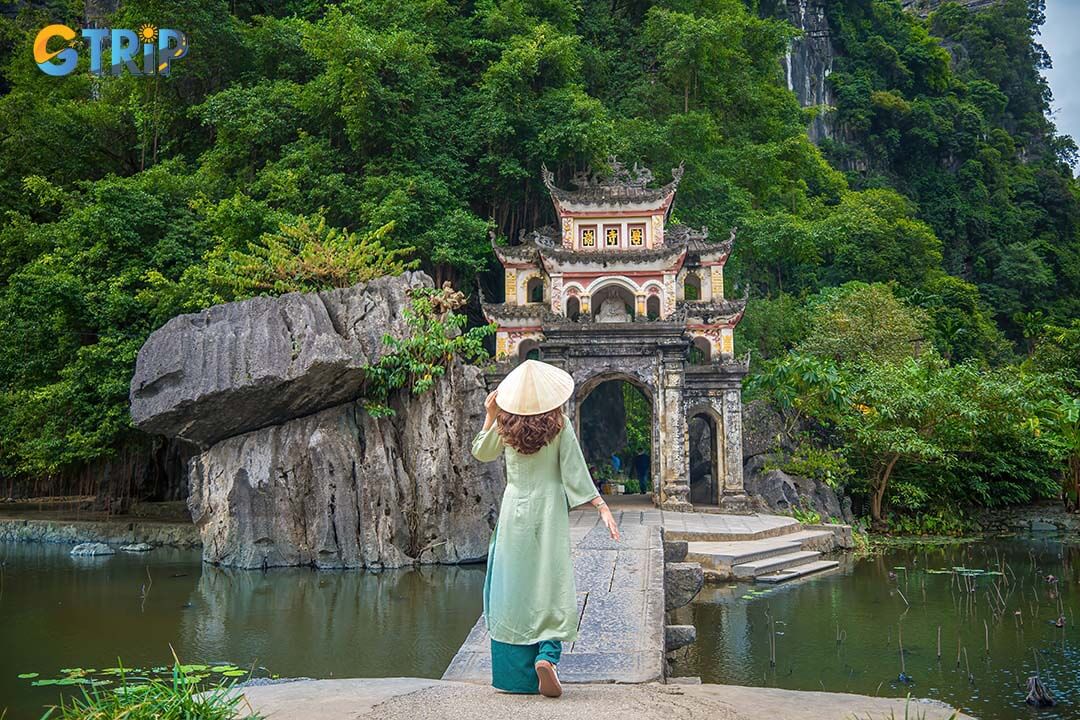
The girl in Ao Dai in front of Bich Dong Pagoda
4. Non Nuoc Pagoda
Non Nuoc Pagoda is uniquely situated atop Duc Thuy Mountain, also known as Poetry Mountain, overlooking the Day and Van rivers in Ninh Binh. This elevated position offers stunning panoramic views of Ninh Binh’s scenic landscape.
Non Nuoc Pagoda has deep historical roots, with its origins tracing back to the Dinh and Le dynasties over a thousand years ago. It was initially constructed as a modest temple dedicated to Buddhist practice and worship. However, it was later renovated and expanded in the 18th century under the Nguyen dynasty. These expansions added architectural elegance and new spiritual significance to the site, transforming it into a major religious and cultural landmark.
Non Nuoc Pagoda hosts vibrant festivals, particularly during the Lunar New Year and the spring festival season, when pilgrims gather to pray for prosperity, peace, and good fortune. These celebrations include traditional ceremonies, incense offerings, and recitations by monks, creating an atmosphere of spiritual renewal and community connection.
The festivities are marked by a colorful array of cultural performances, lion dances, and processions, blending spiritual reverence with joyful celebration. These festivals not only honor Buddhist traditions but also strengthen bonds among local communities.
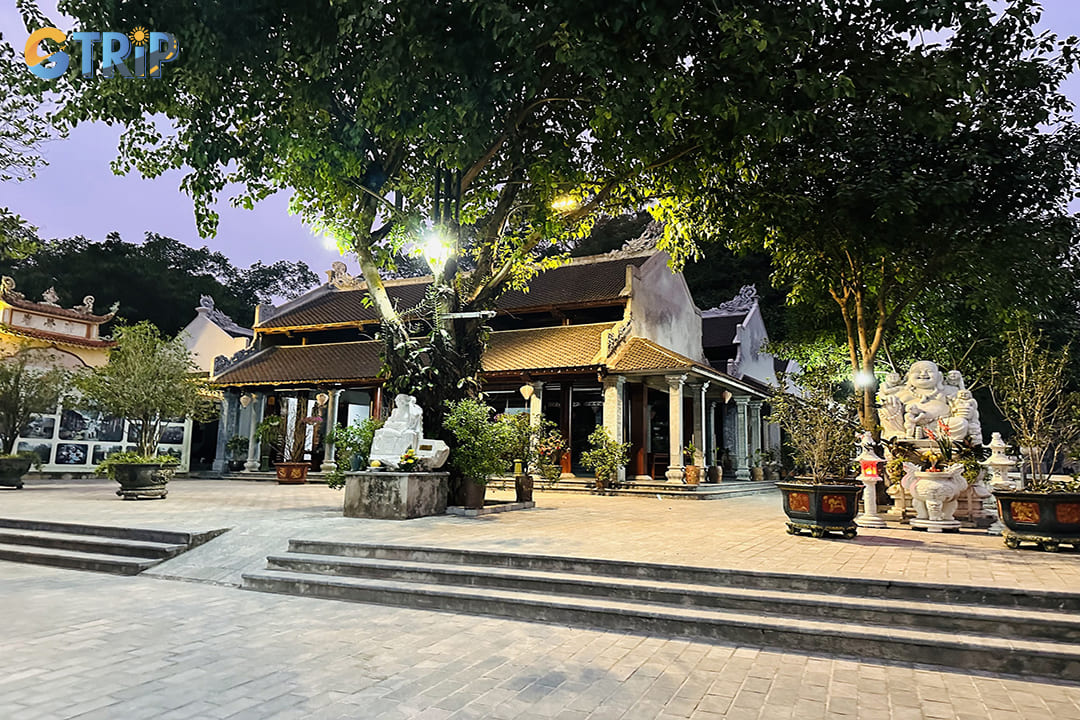
Non Nuoc Pagoda overlooking the day and Van Rivers in Ninh Binh
5. Golden Pagoda
The pagoda was built on the site of the ancient Bat Long Pagoda. It is located on a small island in the middle of Ca Voi Lake, right on Trang An road leading to Trang An.
The Golden Temple was built according to the octagonal architecture with 8 sides facing each other in 8 directions. It symbolizes the worship of the 8 Kings of the 12 ancient armies of Bat Long Pagoda. They are Ngo Xuong Xi, Nguyen Sieu, Pham Bach Ho, Kieu Cong Han, Do Canh Thac, Nguyen Khoan, Kieu Thuan and Nguyen Thu Tiep.
Throughout the campus of the Golden Temple are planted a lot of green trees, from old trees to skillfully trimmed bonsai pots. Around the main temple, there are also three small pagodas featuring different architectural styles. One notable example is a stone building with three floors that gradually tapers upwards, situated on a small circular piece of land that emerges in the middle of the lake.
Golden Pagoda was built based on the old architecture of Bat Long Pagoda – an ancient temple built by King Le Dai Hanh more than 1000 years ago, with an area of 28 hectares. Over the centuries, the pagoda has had a cultural significance in the religious and cultural life of the local community, serving as an important center of Buddhist practice and pilgrimage.
The Golden Pagoda in Ninh Binh attracts many for its stunning architecture and tranquil atmosphere. Guests can explore the temple grounds, photograph the colorful altars, and walk through prayer halls adorned with statues. Offering incense and meditating in designated areas allow a deeper connection to its spiritual ambiance.
Buddhist festivals bring special ceremonies, with monks leading prayers, chanting, and rituals for an immersive experience of Buddhist culture. Informational tours provide insights into the pagoda’s design, history, and significance, making it an engaging site for both spiritual seekers and cultural travelers.
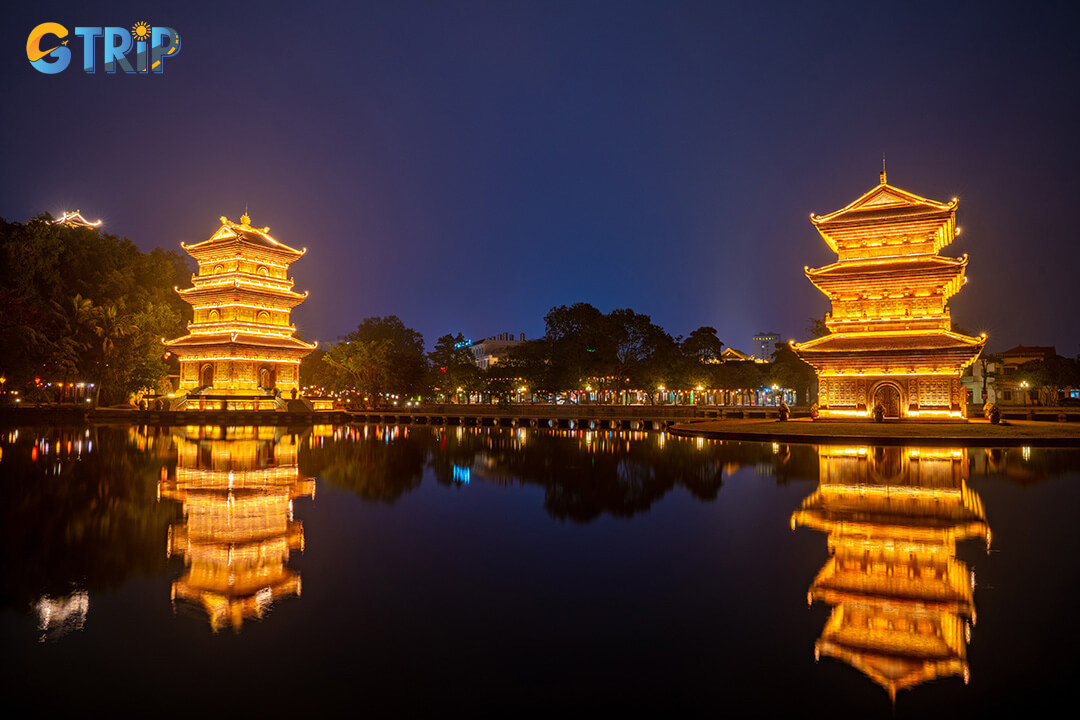
Golden Pagoda on the site of the ancient Bat Long Pagoda
6. Hoa Lu Temple
Hoa Lu Temple, part of the ancient Hoa Lu capital in Ninh Binh, is a place of profound historical importance in Vietnam. It was once the capital of the country under the Dinh and Early Le dynasties (10th–11th centuries). Built to honor Emperor Dinh Tien Hoang and his successor, Emperor Le Dai Hanh, the temple commemorates Vietnam’s early struggles for independence and unity.
The Hoa Lu Temple complex includes the two main temples, Dinh Tien Hoang Temple and Le Dai Hanh Temple. Both are designed in traditional Vietnamese style with wooden structures, curved tile roofs, and intricate dragon and phoenix carvings. Surrounding the temples are various historical relics, like stone statues, altars, and inscriptions. They give visitors a glimpse into the cultural and spiritual practices of the ancient Vietnamese court. The ancient architecture, preserved stone walls, and stunning natural landscape evoke a sense of the past, making Hoa Lu Temple feel like a journey back in time.
Visitors to Hoa Lu Temple can explore the tranquil courtyards, pay respects at the altars, and view historical relics that connect them to Vietnam’s royal past. Many enjoy taking guided tours to learn more about the dynasties that shaped the nation, while others participate in meditation and incense offerings at the shrines. During festivals, such as the Hoa Lu Festival in spring, the site comes alive with traditional music, dances, and reenactments.

Hoa Lu Temple is a part of the Hoa Lu Ancient Capital in Ninh Binh
7. Dich Long Pagoda
Dich Long Pagoda showcases the exquisite beauty of traditional Vietnamese architecture, characterized by its intricate wooden and stone construction. The pagoda features gracefully sweeping roofs adorned with decorative tiles, creating an elegant silhouette against the lush backdrop of its surroundings.
Inside, the main hall is richly decorated with detailed carvings of Buddhist deities and inscriptions that convey the teachings of Buddhism. The thoughtful layout includes various chambers for meditation and worship, all designed to foster a sense of peace and tranquility. The integration of natural elements, such as nearby trees and a flowing river, enhances the pagoda’s serene atmosphere.
With roots tracing back to the Ly Dynasty, Dich Long Pagoda holds a significant place in Vietnam’s spiritual and cultural landscape. While the exact founding date remains uncertain, it has long served as a center for Buddhist teachings and practices.
Over the centuries, the pagoda has undergone numerous renovations to preserve its architectural integrity and historical importance. It has witnessed various significant events and has become a gathering place for the local community. Today, Dich Long Pagoda stands as a testament to the enduring legacy of Buddhism in Vietnam, continuing to attract those seeking spiritual growth and cultural connection.
Travelers to Dich Long Pagoda can engage in a range of spiritual activities conducted at the temple. These activities include meditation, prayer, and the observation of traditional rituals and ceremonies. The pagoda’s serene atmosphere and stunning natural setting also make it a popular destination for those seeking a moment of tranquility and contemplation.

The beauty of Dich Long Pagoda
8. Am Tien Pagoda and cave
Am Tien Pagoda is nestled in a picturesque area of Ninh Binh Province, Vietnam, situated approximately 15 kilometers from the bustling city of Ninh Binh. This serene pagoda is perched on a hill in the scenic Am Tien Valley, surrounded by lush green mountains and tranquil lakes. The pagoda’s location is characterized by its natural beauty, with limestone karsts rising dramatically in the background.
Am Tien Pagoda has a rich history dating back to the 17th century. Originally built during the reign of the Ly Dynasty, it was constructed as a place for meditation and worship for monks and locals alike. The pagoda has undergone several renovations over the centuries, particularly in the late 19th century, to preserve its architecture and enhance its spiritual significance.
Am Tien Pagoda is also known for its association with local legends, including stories of miraculous events and divine encounters. Throughout its history, the pagoda has been a center for Buddhism in the region, attracting pilgrims and spiritual seekers.
Visiting Am Tien Pagoda offers a variety of enriching activities for those looking to immerse themselves in the spiritual and natural beauty of the area. Upon arrival, guests can explore the pagoda’s intricately designed architecture, featuring traditional Vietnamese motifs and stunning sculptures. Walking trails around the pagoda lead to breathtaking viewpoints, where visitors can take in panoramic views of the surrounding valleys and mountains.
Additionally, the tranquil atmosphere is perfect for meditation and reflection, with serene spots available for quiet contemplation. Cultural experiences, such as participating in prayer ceremonies and learning about local Buddhist practices, enhance the visit. This makes Am Tien Pagoda a fulfilling destination for spiritual enrichment and connection with nature.
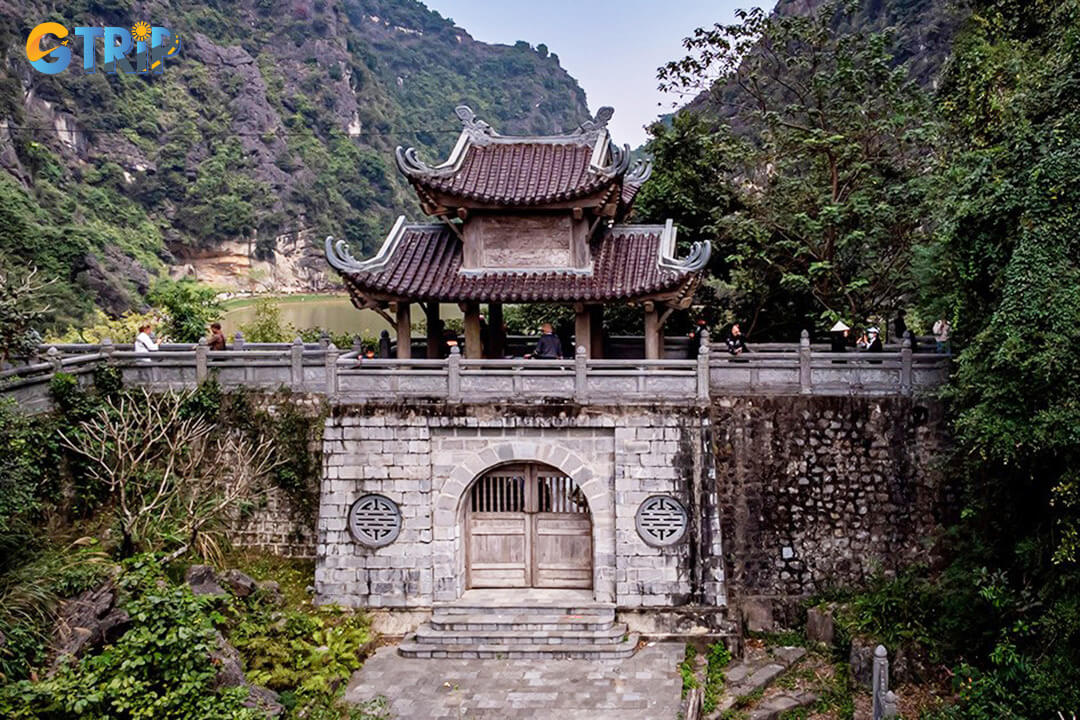
Am Tien Pagoda in the tranquil atmosphere
9. Nhat Tru Pagoda
Nhat Tru Pagoda is a remarkable example of traditional Vietnamese architecture, showcasing the intricate craftsmanship that defines the country’s cultural heritage. The pagoda features a harmonious blend of wooden structures and stone elements, creating an aesthetic that is both functional and spiritually inspiring.
The main hall, known as the sanctum, is adorned with elaborate carvings and paintings depicting Buddhist deities and scenes from ancient folklore. The use of natural materials, such as wood and brick, complements the surrounding landscape, allowing the structure to harmonize with its environment.
The pagoda is further characterized by its tiered roofs, which curve elegantly upward, a design element that symbolizes the connection between the earthly realm and the heavens. The layout of Nhat Tru Pagoda follows the traditional design principles of Vietnamese temples, with a central courtyard that invites contemplation and prayer.
Nhat Tru Pagoda has a storied history that dates back to the 13th century, during the reign of the Tran Dynasty. Originally established as a Buddhist center for monks and laypeople, it has played a significant role in the spiritual life of the local community for centuries. The pagoda was named “Nhat Tru” which translates to “One Pillar” symbolizing unity and strength.
Over the years, it has undergone various renovations and restorations to preserve its architectural integrity and cultural significance. The pagoda is associated with several historical events, including the resistance against foreign invaders during the Tran Dynasty. Today, it stands as a testament to Vietnam’s rich Buddhist heritage and serves as a spiritual haven for those seeking solace and enlightenment.
Visitors to Nhat Tru Pagoda can engage in a variety of enriching activities that enhance their understanding of Buddhism and Vietnamese culture. One of the primary activities is exploring the pagoda’s stunning architecture and historical artifacts, which provide insight into the region’s religious practices.
Guided tours are often available, offering detailed explanations of the pagoda’s significance and the stories behind its artistic elements. Spiritual seekers may participate in prayer sessions or meditation workshops for a deeper connection to the teachings of Buddhism. The peaceful surroundings make it an ideal place for quiet reflection, with several scenic spots for visitors to sit and enjoy the tranquility.
Additionally, the pagoda hosts cultural festivals and ceremonies throughout the year. It provides an opportunity for travelers to witness traditional rituals and engage with the local community.
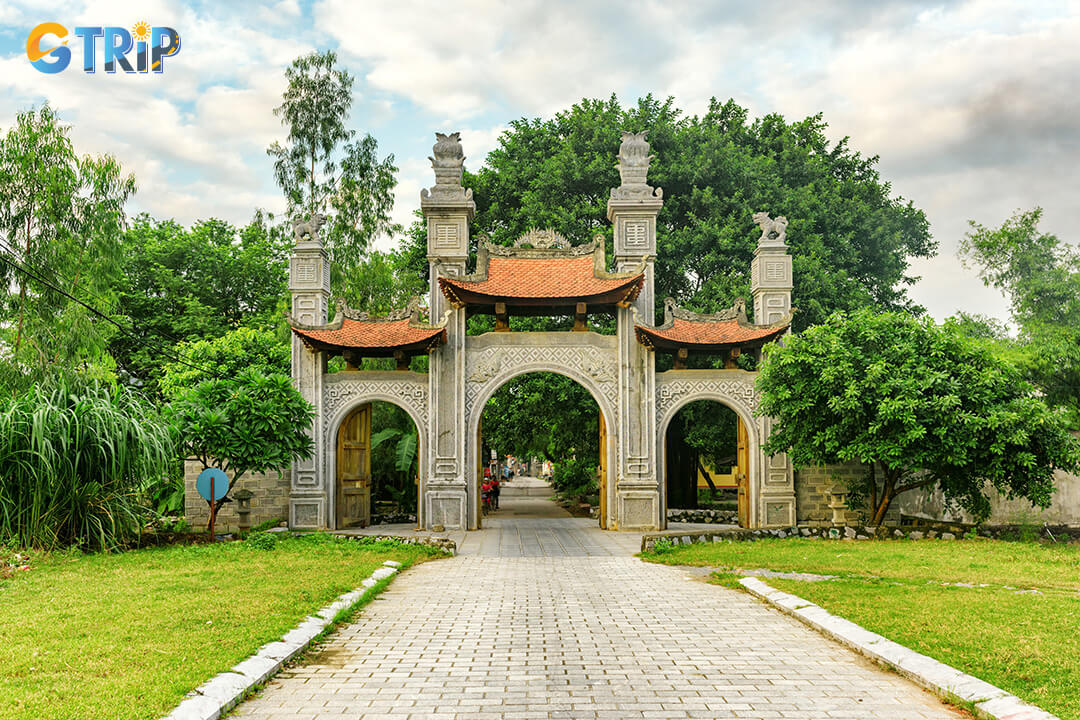
Entrance to Nhat Tru Pagoda
10. Duyen Ninh Pagoda
Duyen Ninh Pagoda is situated in Ninh Binh Province, approximately 7 kilometers from the bustling center of Ninh Binh City. Nestled amidst the tranquil countryside, the pagoda is positioned on a small hill, offering stunning panoramic views of the surrounding landscapes.
Duyen Ninh Pagoda boasts a rich history that dates back to the 14th century, during the Tran Dynasty. Initially built as a place of worship, it has served as a significant spiritual center for the local community over the centuries. The pagoda has undergone several renovations to preserve its structure and enhance its aesthetic appeal. Particularly in the 18th century, it was expanded to accommodate a growing number of devotees.
Duyen Ninh Pagoda is also linked to various local legends and historical figures, which adds to its cultural importance in the region. Today, it stands not only as a religious site but also as a symbol of the enduring spiritual heritage of Ninh Binh.
Duyen Ninh Pagoda is renowned for its impressive architecture and serene ambiance. One of its standout features is the stunning three-entrance gate, adorned with intricate carvings and decorations that reflect traditional Vietnamese design. The pagoda houses a collection of beautiful statues and altars dedicated to various Buddhist deities, enhancing its spiritual significance.
Visitors are often drawn to the peaceful gardens surrounding the pagoda, which are meticulously landscaped and provide a serene space for meditation. Additionally, the pagoda hosts various cultural events and festivals throughout the year, allowing travelers to experience the vibrant local traditions and practices.
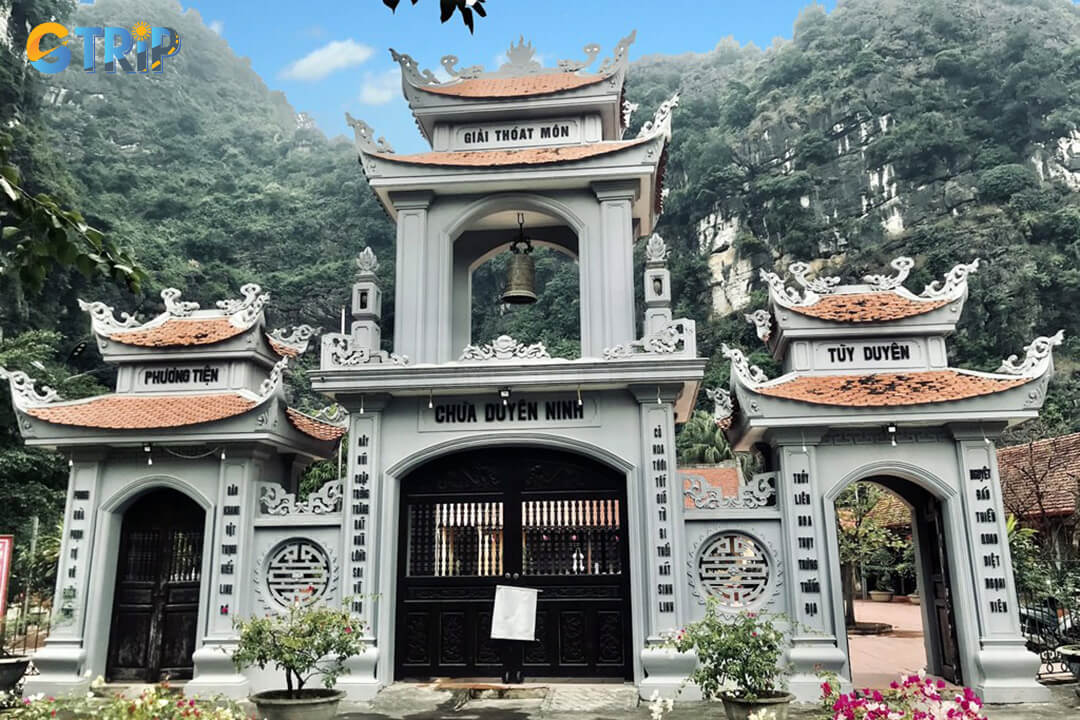
The entrance gate of Duyen Ninh Pagoda
When is the best time to visit Ninh Binh temples?
Visitors seeking to experience the captivating temples of Ninh Binh would do well to time their trip strategically. Ninh Binh’s temples can be visited year-round, but the best times are typically during the spring, from February to April and autumn, from September to November. During these seasons, the weather is pleasant with moderate temperatures and lower humidity, making it ideal for exploring the temples and their surrounding natural beauty.
Additionally, visiting during the Tet holiday, or Lunar New Year, offers a unique cultural experience, as many temples host special ceremonies and vibrant festivities. It’s advisable to avoid the peak summer months, June to August, due to the heat and occasional heavy rains. By planning a trip to Ninh Binh temples during the spring, autumn, or Tet holidays, visitors can make the most of the temples’ timeless beauty and spiritual significance.
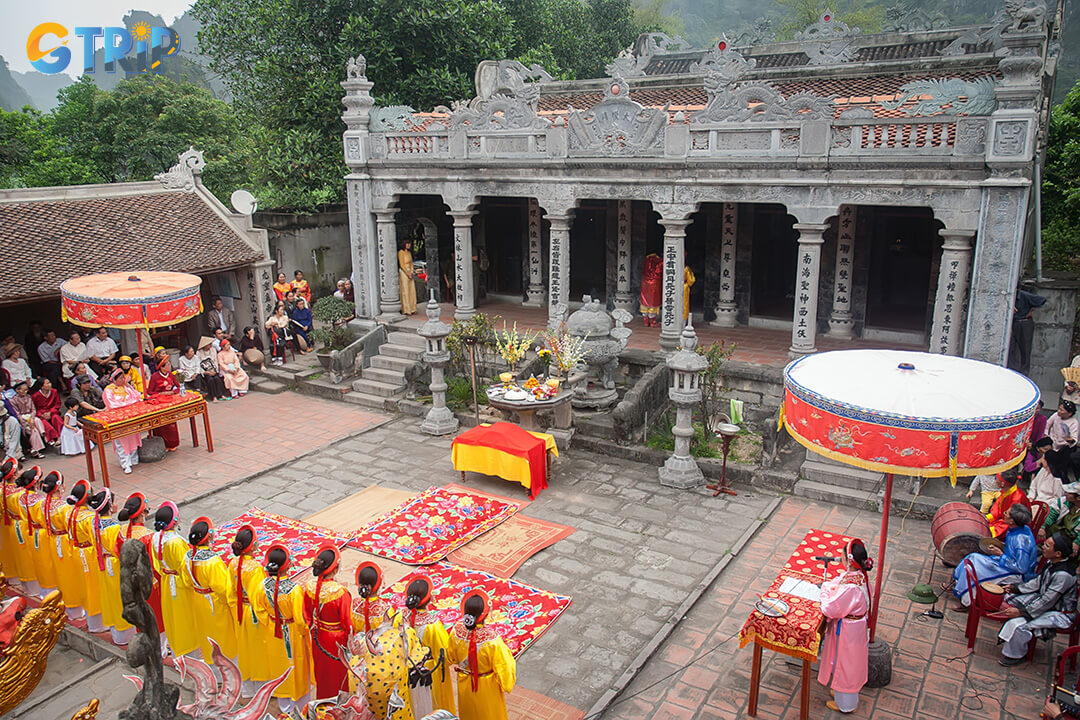
Scene of a festival at Ninh Binh Temple
Tips for travelers when visit Ninh Binh temples
When visiting the temples of Ninh Binh, there are several tips travelers should keep in mind to ensure a respectful and enriching experience.
- Dress modestly: Wear clothing that covers your shoulders and knees to respect local customs and cultural norms. This helps you blend in and show reverence for the sacred spaces.
- Wear comfortable shoes: Choose comfortable, sturdy footwear, as many temple complexes require extensive walking or climbing of stairs. This will ensure you can fully explore without discomfort.
- Stay hydrated: Bring plenty of water, especially during the hot and humid summer months. Staying hydrated will help you maintain your energy and stamina throughout your temple visits.
- Pack snacks: Carry some light snacks like energy bars or dried fruits for day trips. This can be helpful if you find yourself between meals while visiting remote temple sites with limited food options available.
- Arrive early: Try to visit Ninh Binh pagodas early in the day, before the crowds arrive. This allows you to experience the serene, peaceful atmosphere and avoid the busier tourist rush.
- Hire a local guide: Consider hiring a knowledgeable local guide who can provide insightful historical context, cultural significance, and insider tips about the temples you’re visiting.
- Respect local customs: Be mindful of local customs and etiquette, such as removing shoes before entering certain areas, refraining from loud conversations, and avoiding inappropriate behavior that could be seen as disrespectful.
- Follow photography rules: Check if photography is allowed, especially in sacred areas. Avoid using flash photography if it is prohibited, as this can disturb the tranquility of the temple space.
- Be mindful of cleanliness: Dispose of any trash or litter properly, and avoid leaving behind any waste that could negatively impact the cleanliness and preservation of the temple grounds.
- Take your time: Allow yourself to slowly explore and absorb the unique atmosphere of each temple. Spend time observing the architecture, artwork, and spiritual practices to fully appreciate the history and significance of these sacred sites.
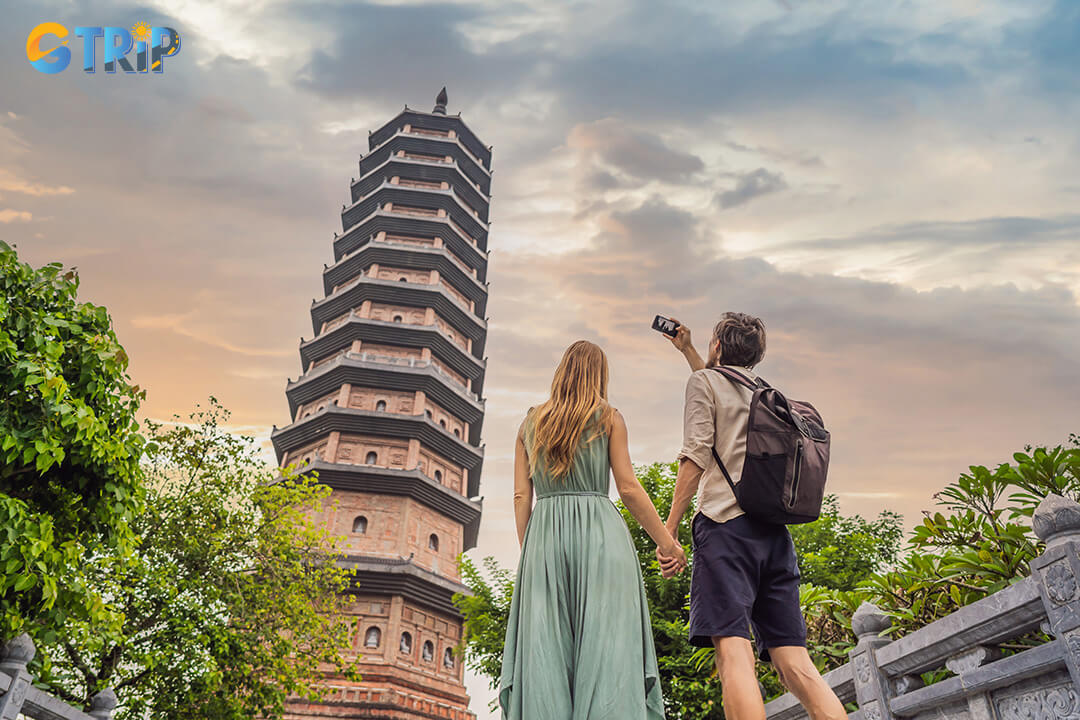
The couple take a nice photos at stupa in Bai Dinh Pagoda
History and culture of Ninh Binh temples
The temples of Ninh Binh trace their origins back centuries, first established during the Dinh and Le dynasties. Over time, these sacred sites have evolved not only architecturally, but also in their crucial role within Ninh Binh’s culture. Far more than historic landmarks, the temples have long served as vital spiritual and communal hubs, hosting Buddhist ceremonies and festivals that preserve the region’s traditional customs. As repositories of cultural identity, the temples house intricate artworks that have inspired local craftsmanship, cementing their status as tangible connections to Ninh Binh’s storied past and shaping its cultural present.
Ninh Binh temples embody the region’s rich cultural heritage, reflecting the profound values and historical significance of the temples. Tracing their origins to influential dynasties, these architectural marvels showcase the technical and artistic prowess of local artisans, whose legacies inspire contemporary craftsmanship. Beyond their aesthetic allure, the temples also serve as repositories of Ninh Binh’s spiritual traditions, hosting ceremonies that preserve the community’s deep-rooted customs. These revered structures stand as living testaments to the enduring values and beliefs that have defined the cultural identity of the region.
In short, the role of temples in Ninh Binh culture is very important to this area and also to the country. The temples of Ninh Binh stand as enduring monuments to Vietnam’s rich cultural and spiritual heritage. These sacred sites have weathered the passage of time, captivating visitors who seek to understand the history and traditions they embody. As testament to the region’s remarkable legacy, the temples of Ninh Binh will continue to inspire awe and reverence for generations to come.





